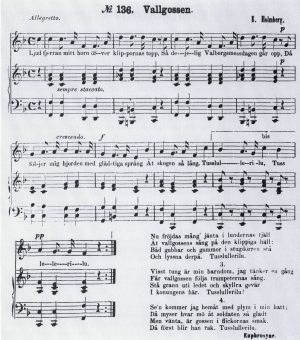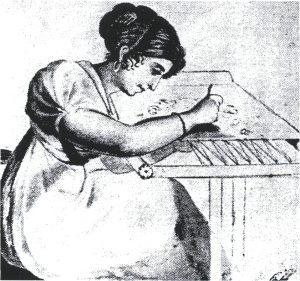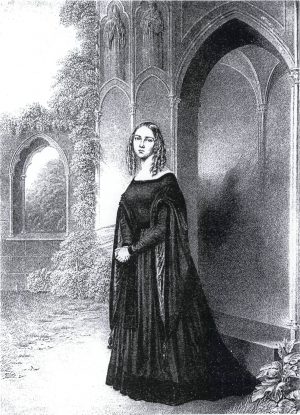The most renowned female author of the Swedish Romantic period, and the one who was the most appreciated in her time, was Euphrosyne, the pseudonym of Julia Christina Nyberg (1785-1854).
Julia Nyberg’s nom de plume is taken from one of the three Graces, who were, in Greek mythology, the half-daughters of Zeus. The name Euphrosyne means something like ‘the joyful’.
She made her debut in 1817 with a couple of poems in Poetisk kalender (Poetical Calendar), one of the most important literary journals of the Swedish Romantic movement. She also contributed to other Romantic publications and had several collections of her own dramatic and poetic works published, the first of which was Dikter (1822; Poems).
Euphrosyne was the daughter of the manager of the Skultuna brass works. Her parents died when she was still a child, and the owner of the brass works took care of her upbringing. Euphrosyne married for the first time when she was twenty-four years old but left her husband after only a couple of years. She eventually forced through a formal separation and, in 1822, remarried with A. V. Nyberg, the new manager at Skultuna.

Euphrosyne was acquainted with and exchanged letters with the Romantic authors in Sweden. P. D. A. Atterbom in particular became her friend and protector in the literary world, and she was greatly influenced by his poetry. Euphrosyne saw herself as a part of the Romantic movement, and she was also treated as such by the literary critics. The critics who swore to the aesthetic ideals of Romanticism usually spoke about her texts with sympathy and appreciation, whereas their literary opponents did the opposite. Euphrosyne’s literary fame seems to have been at its peak in the 1820s.
Euphrosyne embraced motifs and stylistic features from the literary currents of the day. Both Gothicism (the infatuation with the Old Norse culture) and Phosphorism (the hyper-Romantic aesthetics that was cultivated in the journal Phosphoros) influenced her poetry. This influence was perhaps not always of benefit to her writing.
It must have been difficult, for instance, for a female poet to deal with the often comically male-focused and male-glorifying Gothicism. Nevertheless, Euphrosyne and several of her female colleagues grappled with this task.
In Euphrosyne’s writings, Phosphorism sometimes takes a Mannerist turn, where the rhythms, the sound of the words, and the exotic motifs do not always fuse together into a poetic whole. It is in the poems that are the simplest with regard to motif and form that Euphrosyne finds her own tone:
I flee to you, when the eye is quietly closed,
And the day has put out its torch before my eyes;
What memory has offered is poured into the colours of the poem,
And yours, only yours is the rosy garment of sleep.
Jag flyr till Dig, då ögat stilla slutes,
Och dagen för min blick sin fackla släckt;
Hvad minnet skänkt, i diktens färgor gjutes,
Och din, blott Din är sömnens rosendrägt.
Euphrosyne’s poems were very popular in musical circles, and many of her shorter texts were set to music. Emilie Holmberg was one of those who wrote music for her poems. Euphrosyne also wrote new texts for old, popular ballads. One of these, “Vårvindar friska” (Fresh Breezes of Spring), has remained popular in Sweden, right up to the present.
“I have been given two souls: one from my father, and one from my mother. The former is manly, capable, and strong as if it had to mine a mountain; the latter is feeble, tender, and affectionate, even to the extreme. Therefore, I live in eternal conflict with myself, but as soon as passions are involved, I always get aufgeregt and aroused from the torpor that comes with the icy nature of the North. When I love and hate, my soul is in its element”, Euphrosyne writes in a letter of 17 January 1832 to C. F. Dahlgren.
Jingling Words and Playful Rhythms
It is not difficult to understand why composers liked to work with Euphrosyne’s texts – the musical element is quite fundamental to her poetry. The sound of the words and the rhythm of the verses are occasionally even so strongly emphasised that the logic of the language is at risk.
Euphrosyne often found her motifs in fairy tales, folk tales, and myths – completely in agreement with the taste of the period. Nature was another source of inspiration to her. Flowers, birds, and the changing seasons became the subject of several of her most beautiful poems.
In the short poem “Fågelburen” (The Bird-Cage), the stifling, bloodless life in town is contrasted with the free, happy life in nature. A beautiful spring day, the female poetic ‘I’ walks sorrowful about the town. She feels like a prisoner of civilisation. At the market place she meets a man who is selling caged birds. The woman immediately identifies with the birds – “Ack, arma fångar, tänckte jag, / Oss trycker samma ödes lag!” (“Oh, poor prisoners, I thought, / we are oppressed by the same law of destiny!”). She buys them with her last bit of money, walks through the city gates and out of town, sets the birds free, and then rejoices over their song and free flight.
Euphrosyne returned several times to this celebrated motif. In the world of her poetry, the bird – the freest creature in the world – that has been closed up in a small cage and whose natural instinct to fly has been impeded, became a symbol of various forms of imprisonment.
But it was love that she by preference and most ardently sung about. “Jungfrun i det gröna” (The Maiden in the Countryside) was perhaps the most appreciated of Euphrosyne’s poems in her own time. It is about the romance between a flower and a butterfly. All of nature takes part in their feast of love – the winds, the birds, the flowers, and all the winged insects in the air. But the butterfly is an extremely fickle lover, and already the next morning he flies on to the next flower. “Den glömda bruden gråter / I lilla hufvan än, / Och suckar: ‘aldrig åter / Fås denna natt igen’!” (“The deserted bride still cries / in her little hood, / and sighs: ‘Never again / will this night return’!”)
On 22 December 1842, Wendela Hebbe, who worked as a culture editor at the newspaper Aftonbladet in the 1840s, reviews the third volume of Euphrosyne’s Nya dikter (New Poems). The female critic notes the general Romantic character of the poems and their popularity. It is the poems that are “noble” and not the feminine “pursuits”, which may have suffered from the poetical activity.
At the end of the review, Euphrosyne is favourably contrasted with “most of Apollo’s sons, who began to strike the lyre at the same time as she did”, that is, the representatives of the Romantic school, primarily Atterbom and Tegnér. Also the movement of Gothicism, headed by Geijer, which cultivated masculinity, is taken to task.
Wendela Hebbe, who often used the signature ‘Liana’ in Aftonbladet, is not an uninterested party, given her acquaintance with Euphrosyne. She is also the subject of the very flattering poem “I Lianas album” (In Liana’s Album) in Nya dikter. Hebbe got to know Julia Nyberg, alias Euphrosyne, as early as in 1837, when the latter asked her to present her compliments to “the king of the Parnassus”, Esaias Tegnér.
“A new collection of poems by this poetess is always warmly welcomed by the many who love and appreciate poetry that is soulful, noble, and pure. The name Euphrosyne is one of the few in our literature that has retained an undimmed reputation, from the time of Phosphorism and until today, and that has successfully weathered the storms that have made themselves felt for some decades now in Swedish belles-lettres. Euphrosyne understands how to stay true to herself; she has developed in her own direction, unaffected by the influence of this or that poetic celebrity.”
Wendela Hebbe in her review of Nya dikter, on 22 December 1842.
In several poems Euphrosyne wrote about the contemporary literary establishment. Some of these poems were satirical. This is, for example, the case with “Recensenten” (The Critic). In a letter Euphrosyne explained that it is about her relation to her most bitter critic, Anders Lindeberg. The poem begins with a little boy running about in a field and picking flowers. A little ways away a man is sitting, “as proud as in an all-male assembly”. Generously, the boy presents the man with a bouquet, but he does not react as the boy had hoped:
But barely had the man taken the flowers
before, bit by bit, little by little,
he pulled the leaves to pieces…
‘What! Why do you accept my gift with such coldness?
What are you doing here, then, you snow figure?’
‘I am just reviewing’.
Men, knappt har Mannen blomstren fått,
Förr’n, bit från bit, så smått, så smått,
han sönderplockar bladen…
‘Hvad! Motta’r du min skänk så kallt?
Hvad gör du här då, snö-gestalt?’
‘Jag recenserar blot.’
“But if the poems have been given moments that have been taken away from nobler pursuits, if the memory of one single neglected or postponed obligation hovers about the desk, if perhaps a spouse, a child, a household were missing her care, her comfort, her management, while she was tormenting her brain with putting together her verses, then we pity her for the day when she wakes up from her delusion.”
Anders Lindeberg on Euphrosyne in the newspaper Stockholms Posten, nos. 238-242, 1823.
Images of the Feminine
The only prose text that Euphrosyne published was “Den sköna Cunigunda” (The Fair Cunigunda) in Nyare dikter (1828; Newer Poems). To a modern reader, this is perhaps the most interesting of her texts. Here, Euphrosyne lets a number of female figures, taken from the Bible and ancient Egyptian mythology, from contemporary literature, and from the contemporary literary debate, mirror, amplify, or counterbalance each other.

Tales of this kind were already to be found both in literature and in folklore, when Euphrosyne wrote “Den sköna Cunigunda”. However, she was not content with merely writing down an already existing tale, but she interpreted it and developed it in a manner that was all her own. The thorough examination of different images of femininity that is found in Euphrosyne’s text has no counterpart in the earlier versions of the tale.
The story is briefly as follows: Cunigunda lives happily in the castle of her father, the count. One day a handsome knight visits the castle, and there is romance in the air. The knight proposes. The father is delighted. But Cunigunda declines. She is afraid of losing her beauty and her freedom, and she does not want to bear children. From an old woman skilled in magic she obtains a potion that makes her sterile, whereupon she agrees to marry the young man. After many years of pleasure and debauchery she tells the man what she had done, and he disowns her with these words: “A lush palm tree will have to spring up from this cold marble floor, ere I forgive you.” She wanders out into the world, encounters the souls of her unborn children and is at first cursed by them, but later forgiven. She goes mad, arrives at a convent, saws off the marble child from a statue of the Virgin Mary, and later returns as a pilgrim to her husband’s castle. In his sleep, the man says: “Look! What a lovely palm tree with green, shining leaves, springing up over us from the marble floor! – Cunigunda, I have forgiven you.” At that moment she dies.
“Look!”, said the mad Cunigunda, […] “I have taken this smiling child from the bosom of the Mother of God, where all souls come to life before they descend to earth; and when I only warm this figure against my heart, it becomes so calm, so calm in there, and it is as if a mild spring breeze flowed from the childishly beautiful mouth.”
From Samlade dikter 1 (Collected Poems).
The Cunigunda of the tale faces a dilemma, which is a combination of a woman’s biological destiny and the conditions of a woman’s life offered by a patriarchal society. She tries to avoid the biblical God’s punishment of the woman: “To the woman He said, ‘I will greatly multiply your pain in childbearing; in pain you shall bring forth children, yet your desire shall be for your husband, and he shall rule over you.’”
In the beginning of the tale, Cunigunda is weaving a cloth that may be interpreted as an image of the life of an independent but lonesome woman. The young knight wants her to weave another image: an affectionate mother surrounded by her children. When Cunigunda falls in love with the knight, she weaves him into her picture. But she determinedly refuses to have anything to do with his vision of motherhood. She wants to love the knight – but without obligations and without having children. This is an insoluble dilemma in the context of the knightly world of the tale.
This is when Veronica, who is skilled in magic, presents her ‘solution’ to the problem – an infertility drug, whose power derives from a pagan tradition. Veronica comes to Cunigunda in the bride’s room on the night of the wedding. Cunigunda drinks the potion and at the same time casts a glance in the mirror, and sees, to her horror, the shape of a devil above Veronica’s head. After this mirror scene Cunigunda is no longer the same. She understands that she has yielded to the devil’s illusions. This is the absolute turning point in the story, and this is when the process begins through which Cunigunda loses everything she thought she could have gained through Veronica’s trick.
Up to this point, it is Eve/the sinner – one of the two predominant female figures in the Christian imagination – who has been constantly in the background of the text. But after the wedding night and the Fall, it is Mary/the mother of God – the other female biblical figure – who dominates the text. In Euphrosyne’s tale, as in the Christian imagination, Mary atones, through her motherhood, for the sin that Eve has committed.

The tale involves yet another mythical female figure, taken from a non-Christian tradition and represented by the sorceress Veronica. She swears by Osiris, the ancient Egyptian god who was murdered and cut into pieces by his brother but was restored to life by Isis, his faithful spouse and sister. Isis was the mother goddess, and her cult was later connected with the cult of Mary. But she was also a goddess of nature, whose veil disguised the secrets of nature. Only those initiated in the mysteries were able to discern and endure the sight of these dark secrets. Veronica is able to; she is “familiar with nature’s secret powers” and is able to cure those who are ill. In this respect she resembles Isis, whose magic powers were so great that she could heal all the pieces of her husband’s torn-up body and give new life to it. The myth of Isis is then continued in Cunigunda. Through her patient love of a cold marble child, she is eventually able to infuse life into dead matter.
In the beginning of the tale, Cunigunda is aware of the difference between her own images of femininity and those of her surroundings, and she is aware of the difference between images of women’s lives and what is, according to her own experiences, life itself. But in the course of the story it becomes more and more difficult for Cunigunda to distinguish her own images from those of her surroundings, and the borderline between life and the images of life is erased. The images that belong to art are drawn into the world of human beings, and the human beings step into the world of art.
Sorceress Veronica may be seen as a demonic double of the narrator of the tale. It is she who has created Cunigunda’s beauty in accordance with the values prevalent in Cunigunda’s knightly world. At the same time, there is a double sense in which the beauty empties the body of inner life so that the beauty is eaten away from within. It is at a later point, from what remains after this disintegration, that the breeding ground is created for a new and different kind of beauty.
On the face of it, Euphrosyne’s tale may be characterised as a Christian morality tale. But it is also something else and more than that. The way in which she consistently contrasts different images of femininity with each other, allowing them to be transformed or fragmented, means that the text may also be read as a rejection of the patriarchal poetic universe of Romanticism.
The text is written in the Romantic style of the fairy tale and in a ponderous language full of metaphors. But here and there, there are touches of irony that create a distance to the, at times, rather bombastic style. In some passages in which Cunigunda speaks with her father and with the knight, the narrator makes fun of their ponderous language by letting Cunigunda’s body movements demystify and undermine the men’s patriarchal conversation about her body.
Translated by Pernille Harsting

